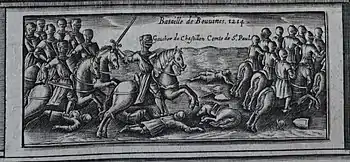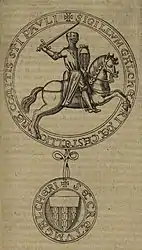Walter III of Châtillon
Walter III of Châtillon (French: Gaucher III de Châtillon ; Latin: Gualcherius de Castellione) was a French knight and Lord of Châtillon, Montjay, Troissy, Crécy et Pierrefonds until his death in 1219. With his marriage, he became Count of Saint-Pol. He was also the Butler of Champagne and the Seneschal of Burgundy.
Walter III of Châtillon | |
|---|---|
| Lord of Châtillon | |
 | |
| Reign | 1191–1219 |
| Predecessor | Guy III of Châtillon |
| Successor | Guy IV of Châtillon-Saint-Pol Hugh of Châtillon-Saint-Pol |
| Titles and styles | |
| Born | c. 1166 |
| Died | October 1219 |
| Noble family | House of Châtillon |
| Spouse(s) | Elisabeth of Saint-Pol |
| Issue
Guy IV of Châtillon-Saint-Pol Hugh of Châtillon-Saint-Pol Béatrix de Châtillon-Saint-Pol Eustachia de Châtillon-Saint-Pol | |
| Father | Guy II of Châtillon |
| Mother | Adèle of Dreux |
Biography

Walter was the second son of Guy II of Châtillon and Adèle of Dreux. After his father's death in 1170, his eldest brother became Lord of Châtillon and Walter assist him in his functions while his youngest brother, Robert of Châtillon, do an ecclesiastical career and became bishop of Laon in 1210 until his death in 1215. By his mother, he was the cousin of the french King Philip Augustus.[1]
In 1189, Walter and his eldest brother Guy participated in the Third Crusade and arrived at the siege of Acre with the King Philip Augustus the 30 March 1191,[2] but Guy III of Châtillon died during the fight and Walter became the new Lord of Châtillon.[3] After the fall of the city and the departure of the french King, he stayed in Holy Land and fought in the battle of Arsuf and the battle of Jaffa. He probably left the Crusade for Châtillon in late 1192.[4]
After being noticed fot his war habilities during this Crusade, he was named Butler of Champagne[5] then Seneschal of Burgundy in 1196.[6]
In 1196, he married Elisabeth of Saint-Pol, daughter and heiress of Hugh IV of Campdavaine, Count of Saint-Pol, and his wife Yolande of Hainaut, and in 1205 he succeeded his father-in-law as count of Saint-Pol.[7] With his wife, he founded a new town named Villeneuve-le-Comte in the forest of Crécy-la-Chapelle.[8]
In 1203, he joined the french army with the duke Odo III of Burgundy and the constable of Champagne Guy II of Dampierre in the conquest of Normandy against the english King John Lackland. He fought in the Siege of Château Gaillard and the catch of Falaise, Caen, Bayeux and Rouen.[9]
In 1209, he participated in the initial campaign of the Albigensian Crusade and fought at the siege of Béziers then Carcassonne. His habilities attracted the king's attention who gave him an army to fight against the English King in Brittany.[10][11]
In 1213, he fought again for the King in Flanders and Hainaut and took for him the city of Tournai and Mortagne.[12][11] Before the battle of Bouvines the 27 July 1214, several French Lord doubted his loyalty and he answered that on that day the king would find in him a good traitor. During the battle, he charged and crossed enemy ranks several times, causing many trouble.[13]
During the war of the Succession of Champagne, he supported the Countess-Regent Blanche of Navarre and her son Theobald against the pretender Erard of Brienne-Ramerupt and his wife Philippa of Champagne.[14]
In 1219, he took the cross for the third time of his life and was back at Albigensian Crusade. He fought at sieges of Marmande then Toulouse. He died in October 1219, probably during a battle.[15]
William the Breton, a contemporary chronicler of Walter, described him as the bravest in arms of his time.[16]
Walter appears in William Shakespeare's history of King John.
 Walter III of Châtillon at the battle of Bouvines.
Walter III of Châtillon at the battle of Bouvines. Seal of Walter III of Châtillon.
Seal of Walter III of Châtillon. .Chruch of Villeneuve-le-Comte, builded from 1203 to 1214.
.Chruch of Villeneuve-le-Comte, builded from 1203 to 1214.
Family

In the year 1196 he married Elisabeth of Saint-Pol, daughter of Hugh IV of Campdavaine, Count of Saint-Pol, and Yolande of Hainaut, and had four children:[17]
- Guy IV of Châtillon-Saint-Pol, Count of Saint-Pol after his father's death.
- Hugh of Châtillon-Saint-Pol, Lord of Châtillon after his father's death, the Count of Saint-Pol after his brother's death.
- Béatrix de Châtillon-Saint-Pol, married to Aubert of Hangest, lord of Senlis.
- Eustachia de Châtillon-Saint-Pol, married in 1215 to Daniel of Bethune, and later married to Robrecht II of Wavrin, marshal of the County of Flanders.
After Walter's death, Elisabeth of Saint-Pol married secondly Jean of Béthune, Lord of Béthune.[17]
Notes
- Rémy 1881, p. 77.
- Despréaux 1824, p. 21.
- Rémy 1881, p. 78.
- Despréaux 1824, p. 22.
- d'Arbois de Jubainville 1865, p. 499.
- Petit 1889, p. 109.
- Nieus, Jean-François. "Élisabeth Candavène, comtesse de Saint-Pol (1205-1240/47) : une héritière face à la Couronne". Femmes de pouvoir, femmes politiques durant les derniers siècles du Moyen Âge et au cours de la première Renaissance: 185–211.
- Viré, L. (1868). "Rapport sur la charte constitutive de la Villeneuve-le-Comte". Revue des sociétés savantes. 7: 63.
- Du Chesne 1621, p. 57.
- Du Chesne 1621, p. 59.
- Despréaux 1824, p. 23.
- Du Chesne 1621, p. 60.
- Petit 1889, p. 202.
- d'Arbois de Jubainville 1865, p. 127.
- Rémy 1881, p. 79.
- Du Chesne 1621, p. 66.
- Foundation for Medieval Genealogy.
Sources
- Du Chesne, André (1621). Histoire de la maison de Chastillon sur Marne.
- Despréaux, Simien (1824). Histoire de la maison Chastillon-Chastillon. Paris: Goujon et Larnault.
- d'Arbois de Jubainville, Henri (1865). Histoire des ducs et comtes de Champagne, tomes 4a et 4b. Paris: Librairie Auguste Durand.
- Rémy, Ange (1881). Histoire de Châtillon-sur-Marne. Reims: Imprimerie E. Bugg, successeur de A. Lagarde.
- Petit, Ernest (1889). Histoire des ducs de Bourgogne de la race capétienne, tome 3. Dijon: Imprimerie Darantière.
- Evergates, Theodore (2007). The Aristocracy in the County of Champagne, 1100-1300. University of Pennsylvania Press.
| Preceded by Hugh IV of Saint-Pol |
Count of Saint-Pol with his wife Elisabeth of Saint-Pol 1205–1219 |
Succeeded by Guy IV of Châtillon-Saint-Pol |
| Preceded by Guy III of Châtillon |
Lord of Châtillon 1191–1219 |
Succeeded by Hugh of Châtillon-Saint-Pol |
